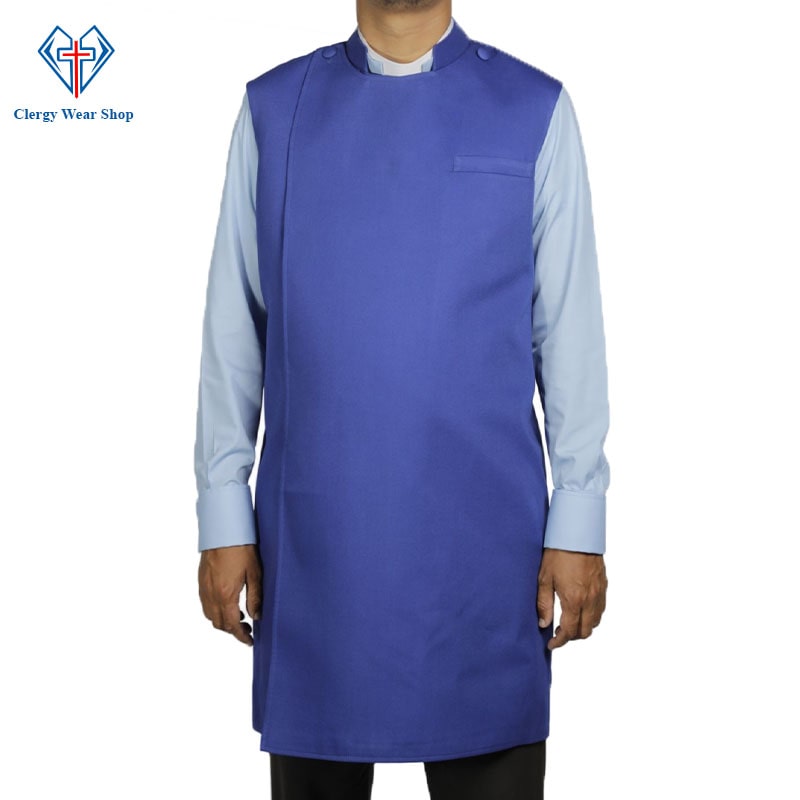Clergy Robes for Men
What is a Clergy Apron?
Clergy aprons are unique items of clothing that are typically worn by religious leaders such as pastors, priests, and bishops. These aprons have a rich history and are used in various religious ceremonies and events.
If you have ever attended a religious ceremony, you may have noticed that the officiants or clergy members wear unique garments or vestments. One of the most prominent vestments worn by the clergy is the clergy apron. The clergy apron is a garment that is worn over the regular clothing by the clergy during religious services or ceremonies. In this article, we will discuss the importance and significance of the clergy apron in religious ceremonies.
What is a Clergy Apron?
The clergy apron is a type of vestment that is worn by the clergy or religious leaders during religious services or ceremonies. It is a long garment that covers the front of the body, and it is usually made of silk or linen. The clergy apron can come in various colors, depending on the occasion or the liturgical season.
The Origin of the Clergy Apron
The use of vestments in religious ceremonies dates back to the early days of Christianity. In the early Church, the vestments worn by the clergy were simple and plain. However, over time, the vestments became more elaborate and ornate. The clergy apron, in particular, is believed to have originated in the 16th century.
The Symbolism of the Clergy Apron
The clergy apron is more than just a piece of clothing. It is rich in symbolism and significance. Here are some of the symbolic meanings associated with the clergy apron:
- Purity
The color white is often associated with purity, and it is a common color for the clergy apron. The white clergy apron symbolizes the purity of the clergy and their commitment to serving God.
- Authority
The clergy apron is a symbol of the clergy’s authority in the Church. It signifies their role as spiritual leaders and guides.
- Humility
The clergy apron is a reminder of the clergy’s commitment to humility and service. It is a symbol of their willingness to serve others and to put the needs of others before their own.
The Significance of the Clergy Apron in Religious Ceremonies
The clergy apron plays a significant role in religious ceremonies. Here are some of the ways in which the clergy apron is used:
- Protection
The clergy apron provides protection for the clergy’s regular clothing during religious services. It also protects the garments from wear and tear.
- Decoration
The clergy apron adds to the overall beauty and decoration of the religious ceremony. The different colors and designs of the clergy apron can add to the ambiance of the occasion.
- Distinction
The clergy apron helps to distinguish the clergy from the congregation. It helps the congregation to identify the clergy and to show respect and honor to them.
Conclusion
In conclusion, the clergy apron is an important vestment worn by the clergy during religious services and ceremonies. It is rich in symbolism and significance and plays a significant role in the overall beauty and decoration of the occasion. The clergy apron serves as a reminder of the clergy’s commitment to purity, authority, and humility. It also provides protection for their regular clothing and helps to distinguish them from the congregation.
Frequently Asked Questions (FAQs)
Why do clergy members wear vestments during religious services?
Clergy members wear vestments as a symbol of their authority and as a way of distinguishing themselves from the congregation.
Difference between a clergy apron and a stole?
A clergy apron covers the front of the body and is worn over the regular clothing during religious services. On the other hand, a stole is a long, narrow scarf-like vestment worn over the shoulders by the clergy during religious services.
Can a clergy apron be worn by both men and women?
Yes, both men and women can wear clergy aprons, although the design and style may differ based on the religious tradition or denomination.
Colors of the clergy apron, and what do they symbolize?
The color of the clergy apron can vary depending on the occasion or liturgical season. White symbolizes purity, red symbolizes the Holy Spirit or martyrdom, purple symbolizes penance or mourning, and green symbolizes hope or growth.
Can a layperson wear a clergy apron?
No, a clergy apron is reserved for the clergy or religious leaders who have been ordained to serve in the Church.

 Clergy Robes for Men
Clergy Robes for Men Clergy Robes for Women
Clergy Robes for Women Clergy Shirts for Men
Clergy Shirts for Men Clergy Shirts for Women
Clergy Shirts for Women